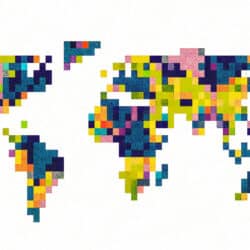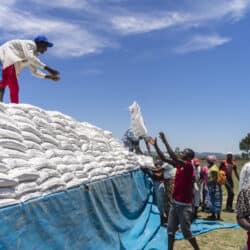Two new books explore post-pandemic developments in organized philanthropy across Africa, Asia, and the Middle East. They argue the merits of a new approach to philanthropy in these regions, more strongly focused on partnerships, networks, and innovation to create more impact.
Reimagining Philanthropy in the Global South: From Analysis to Action in a Post-COVID World, edited by Clare Woodcraft, Kamal Munir, and Nitya Mohan Khemka. Cambridge University Press, 2024; online ISBN 9781009400565
The Business of Philanthropy: Perspectives and Insights from Global Thought Leaders on How to Change the World, by Badr Jafar. HarperCollins UK, 2024; 336 pages; ISBN 9780008620950
In today’s instant media world, we are only too aware of poverty, hunger, and conflict across the world, particularly in the Global South. Many worry about the lingering damage post-pandemic to the achievement of the United Nations Sustainable Development Goals. But less attention has been paid to what is a more positive development: the way in which the pandemic catalyzed the growth of strategic local private philanthropy within emerging economies. As we look closer, we see that the pandemic may have indeed accelerated collaborative partnerships and more transparent and ambitious efforts by philanthropic foundations right across the Global South.
Now, we have an opportunity to hear directly from foundation leaders whose names are not familiar to North American audiences, in contrast to the names of global private funders such as Gates, Rockefeller, Ford, and Mott. Two new books explore developments in organized philanthropy across Africa, Asia, and the Middle East, and how philanthropy has responded to the pandemic and after. Reimagining Philanthropy in the Global South, edited by three Cambridge University–based researchers – Clare Woodcraft, Kamal Munir, and Nitya Mohan Khemka – was published in digital form in February 2024. The Business of Philanthropy: Perspectives and Insights from Global Thought Leaders on How to Change the World, by Badr Jafar, a United Arab Emirates philanthropist and business leader, is forthcoming this fall.
Both books focus on telling compelling stories about funders who are using their local roots and global connections to jump-start more systemic change in their countries. The goal of the Cambridge researchers is “to amplify the voices of leaders in the Global South who have developed their own parameters around best practice and have already tested new thinking and new ideas about how we can do things better.” Their book is “also a call to action for a more united community of global change-makers who believe that philanthropy can have a disproportionately powerful role in changing and improving socio-economic realities of the developing world but only if it undergoes a radical transformation.” Jafar’s book centres the personal stories and views of more than 40 funders and philanthropists, most of whom are in what he calls the emerging markets and whom he interviewed between 2020 and 2024. Both books argue the merits of a new approach to philanthropy in these regions, more strongly focused on partnerships and networks to create more impact.
Both books argue the merits of a new approach to philanthropy in these regions, more strongly focused on partnerships and networks to create more impact.
The Global South covers many diverse regions and countries across Asia, the Middle East, and Africa, as well as South America. The sheer diversity of these countries makes it difficult to apply an umbrella description like “Global South.” Typically, most countries in the Global South have been viewed as “emerging” or “developing” economies with higher rates of poverty and poor health than in the Global North. The lens of “international development and aid” has focused our attention on the governments, NGOs, and large private foundations in the Global North and West whose funds have been directed to humanitarian and development goals such as public health, sustainable farming and food production, education, and water and sanitation. Many of these countries are also dealing with conflict, climate change, and refugee and migrant flows, which have engaged funders across borders in supplying humanitarian aid.
The focus on cross-border philanthropy has obscured the importance of local or domestic philanthropy. Arguments about the “localization of aid” are pointing us back to the presence of the local organizations rooted in communities and their local donors. Local giving is nothing new. There are ancient cultures of giving across Asia, Africa, and the Middle East (the regions on which these two books concentrate). Religious belief, community expectations, and familial obligations all ensure that giving to others is widespread. Yet while it is universally present, philanthropy has also been informal and generally discreet. Much wealth is created and held through family businesses, and privacy is highly valued both in business and in philanthropy. Giving has been anonymous or done with little expectation of public recognition. Historically, philanthropy has not been seen as a catalyst for innovation or an instigator of social change.
We should not assume that Asian, African, and Middle Eastern foundations are directly comparable to North American and European philanthropies. The political and cultural contexts in which they operate are quite different.
In the last three or four decades, a more organized philanthropy has taken shape as wealthy families and businesses (often overlapping) create foundations of their own. However, as these two books make clear, we should not assume that Asian, African, and Middle Eastern foundations are directly comparable to North American and European philanthropies. The political and cultural contexts in which they operate are quite different. In most countries, restrictive or weakly developed regulatory frameworks make it difficult to register or operate a charity. Civil society organizations exist but are weak or constrained. Donors do not have as many non-profit organizations to work with as partners, or don’t trust in their ability to deliver. Because of this, family-run corporate foundations or private foundations, unlike most Western foundations, often create and operate their own programs. And there is much we don’t know about these philanthropies. There is little publicly available data on philanthropic activity, and until more recently, there was little domestic research and learning, although, as these books describe, philanthropic peer-learning networks are beginning to form and expand, particularly in Asia.
These are regions with huge populations, and the challenges of education and health for children and youth are enormous, particularly in Africa. For this reason, and because of the cultural and familial importance accorded to education across the regions, private philanthropy has invested heavily in supporting education, particularly at early stages. Jafar interviewed foundation leaders and donors from Saudi Arabia to Nigeria, from Malaysia to Indonesia, from India to the UAE, and they tell rich personal stories of their involvement in and passion for improving education opportunities for the most disadvantaged. The Cambridge editors, who have pulled together articles from 13 emerging-market network leaders, researchers, and funders, document much the same efforts to boost underfunded and poorly functioning education systems (although education is not the only priority area that is illustrated in these case studies and interviews).
While Jafar’s book takes a personal and anecdotal approach and the collection of articles from Cambridge is more analytic and scholarly, both books demonstrate that the pandemic accelerated the engagement of many of these newly prominent philanthropic foundations in collaboration with each other and with the state. Many of the funders who were already committed to supporting wider access to more effective education saw with consternation the impact of forcing children away from school without access to digital tools. Philanthropists saw the chance to use their corporate or individual digital assets and networks to mobilize support for children and parents and to make remote education more widely accessible.
The story of the YTL Foundation in Malaysia, a story told in both books, is an example of how a private foundation run by a family-owned business moved rapidly to develop a coordinated emergency response to support learning in Malaysia after lockdown, focusing on children from low-income families. Their Learn from Home initiative took full advantage of YTL’s corporate assets of education technology and communication systems to provide smartphones and digital lessons to thousands of families. Realizing they couldn’t do it alone, they brought in as partners the teachers’ unions, community schools, NGOs, and volunteer groups that provided after-school tuition to underprivileged students. They enlisted the Government of Malaysia in providing a subsidy to families to acquire smartphones and data plans and with this support rolled out smartphones to more than 750,000 families. This pandemic experience taught the foundation much about the need to work on resilience in the education system. As Kathleen Chew, the leader of the YTL Foundation, put it: “To move forward, we must continue to foster strong partnerships between the government, the private sector, and NGOs . . . In the case of the Learn from Home initiative, it was necessary for a telecommunications company as well as suppliers of smartphones to get involved in what was essentially an education-led initiative. YTL Foundation will . . . deepen its partnerships with the government, NGOs, and other private-sector companies to build resilience and preparedness for the next disruption. We at the Foundation have learnt that to build a resilient education ecosystem, we need everyone to be involved.”
The new Global South foundations have opportunities to leapfrog over the philanthropic sectors of the Global North with their partnerships and their digital and financial tools.
Both of these books chronicle the confluence of several elements that are leading to the rapid growth of what is becoming a more powerful philanthropic sector: the rise of wealth in high-growth economies of Africa and Asia; the widespread adoption and deployment of digital technologies; the rise of a new generation (millennial to Gen Z) coming into philanthropy; the development of philanthropic infrastructure such as peer networks and research centres; and intensifying interest in collaborative funding, impact investing, and social finance. While the number of foundations in North America still overshadows the numbers in Africa, Asia, and the Middle East, the enormous populations of these regions means that the scale of foundation initiatives is potentially far greater in these regions. However, this scale cannot be realized without government policies and programs. The foundations profiled in these two books understand this well. From the YTL Foundation in Malaysia to the Tanoto Foundation in Indonesia, from the Rohini Nilekani Philanthropies to the EdelGive Foundation in India, from Community Jameel to the King Khalid Foundation in Saudi Arabia (all cited in one or both books), the story is of cross-sectoral collaboration in a clear understanding of the role and leadership of government in sustaining and spreading social investments.
While different in tone and approach, both books share a purpose. They see organized philanthropy as a sector with still unrealized potential for great public benefit. The new Global South foundations have opportunities to leapfrog over the philanthropic sectors of the Global North with their partnerships and their digital and financial tools. The focus provided by the Sustainable Development Goals, the shock of the pandemic, and the increasing urgency of the climate crisis, whose impacts are felt very strongly in the Global South, are combining to accelerate philanthropic effort. But both books argue that more investment is needed to realize the potential. The Cambridge editors focus on three areas that they deem critical to the improvement and institutionalization of best practice in philanthropy: building multi-sector partnerships, fortifying networks, and creating institutional resilience. Jafar focuses as well on the need for building and strengthening networks, fostering more collaboration, and driving forward innovation. They agree that philanthropy in the Global South, even if developing rapidly, must and can do more, in a world that is increasingly likely to experience major shocks from climate change, political conflict, or war. The hope of these authors is that their books will offer learning, inspiration, and urgency to philanthropic action in the Global South. We can and should be inspired by the work of foundations that do not feature in the North American–focused literature on organized philanthropy. In my view, experienced philanthropies in the Global North, too, can learn a good deal from the examples and stories told by these capable philanthropic peers in the rest of our world.


